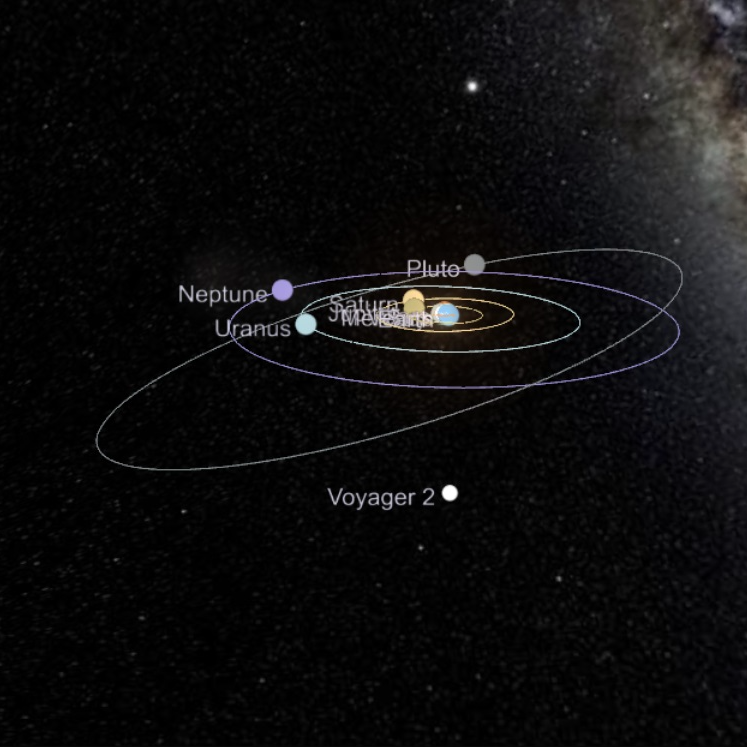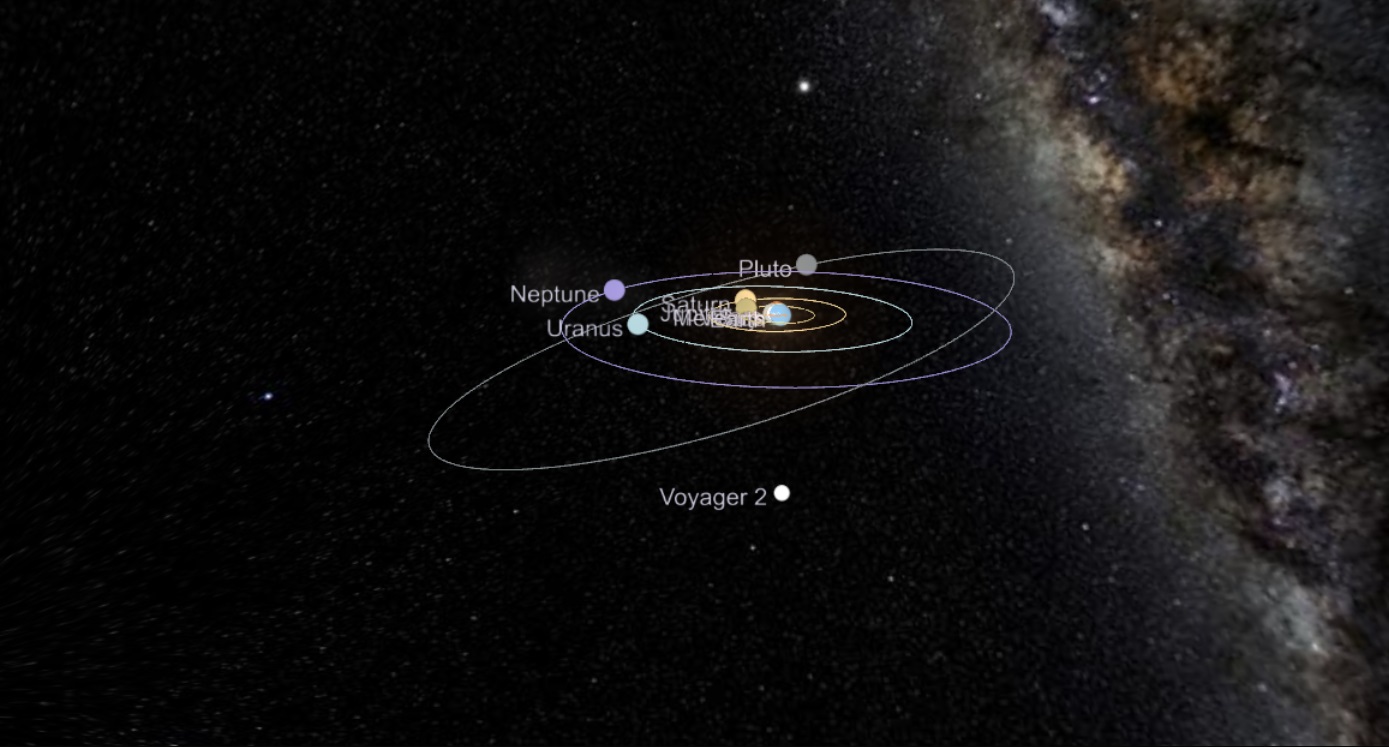How Fast Does Voyager travels at a speed of about 38,610 miles per hour. Launched by NASA in 1977, Voyager is one of the fastest man-made objects ever created.

The Voyager spacecraft, including Voyager 1 and Voyager 2, travel at incredible speeds through space.
- Voyager 1: It is the fastest of the two and is traveling at approximately 38,000 miles per hour (about 61,000 kilometers per hour).
- Voyager 2: Voyager 2 is moving at a slightly slower speed of about 34,000 miles per hour (around 55,000 kilometers per hour).
Additional Context:
Voyager 2: Also launched in 1977, Voyager 2 followed a different trajectory and passed through the outer planets, including Uranus and Neptune. It entered interstellar space in 2018.
It has been venturing through space for over 40 years, exploring the outer reaches of our solar system and beyond. Equipped with scientific instruments and a golden record containing sounds and images of Earth, Voyager has provided valuable data and fascinating discoveries throughout its historic journey.
Voyager 1: Launched in 1977, Voyager 1 is the most distant human-made object from Earth. It entered interstellar space in 2012, which means it has passed beyond the influence of our solar system’s heliosphere.
This remarkable spacecraft has surpassed all expectations and continues to travel through interstellar space, serving as a testament to human ingenuity and our insatiable curiosity about the cosmos. We will delve deeper into the incredible speed and achievements of Voyager, shedding light on its remarkable voyage through the universe.
The Voyager Missions
The Voyager missions were a significant milestone in space exploration, featuring two unmanned spacecraft, Voyager 1 and Voyager 2, which were launched by NASA in 1977. These missions marked the first time that a man-made object had ventured beyond the outer planets of our solar system. Voyager 1 and Voyager 2 are known for their incredible longevity and remarkable discoveries, providing invaluable data about our solar system and beyond.
Launch And Objectives
The Voyager missions were launched in 1977 with the primary objective of conducting a grand tour of the outer planets—Jupiter, Saturn, Uranus, and Neptune. The spacecraft aimed to collect data on these planets, their moons, and their surrounding magnetic and radiation environments. Voyager 1 and Voyager 2 were equipped with various scientific instruments to study these celestial bodies, providing unprecedented insights into the outer regions of our solar system and interstellar space.
Journey Into The Unknown
The Voyager missions embarked on a groundbreaking journey into the unknown, traveling at remarkable speeds. Voyager 1 is currently the farthest human-made object from Earth, venturing into interstellar space, while Voyager 2 is also en route to interstellar space after exploring the outer planets. These missions have expanded our understanding of the outer solar system and have continued to transmit valuable data despite the vast distances they have traversed.

Credit: earthsky.org
Voyager 1 And Voyager 2
Voyager 1 and Voyager 2 are two of NASA’s most remarkable space missions. Launched in 1977, these interstellar robotic explorers have significantly contributed to our understanding of the outer solar system. Let’s take a closer look at these two extraordinary spacecraft and explore their key similarities and differences.
Key Similarities
Both Voyager 1 and Voyager 2 were designed and built to perform similar scientific missions within the solar system. They were tasked with studying the outer planets, their moons, and the environment surrounding them. Equipped with various scientific instruments, these spacecraft provided invaluable data that revolutionized our knowledge of Jupiter, Saturn, Uranus, and Neptune.
One of the key similarities between the two Voyager missions is their remarkable longevity. Despite being launched over four decades ago, both spacecraft are still operational and continue to send data back to Earth through the Deep Space Network. This exceptional endurance is a testament to the ingenuity and craftsmanship of the engineers who designed these space probes.
Key Differences
While Voyager 1 and Voyager 2 share many similarities, they also have several significant differences. One of the most notable differences is their respective trajectories. Voyager 1 was directed to take a slightly shorter and faster path through the solar system, allowing it to reach interstellar space ahead of Voyager 2. In September 2013, Voyager 1 became the first human-made object to venture into interstellar space, marking a historic milestone in space exploration.
Another notable distinction between the two missions is their encounters with the outer planets. Voyager 1 focused primarily on studying Jupiter and Saturn, while Voyager 2 magnificently extended its journey to explore Uranus and Neptune as well. The extended mission of Voyager 2 provided invaluable insights into these ice giants, including extraordinary close-up views of their moons and rings.
Furthermore, Voyager 1 and Voyager 2 were launched on different dates and followed different flight paths, resulting in variations in their current speeds. Voyager 1 is currently traveling at about 17 kilometers per second (38,000 miles per hour), while Voyager 2 is slightly slower at approximately 15 kilometers per second (35,000 miles per hour). These speeds are truly astonishing and demonstrate the incredible capabilities of these interstellar travelers.
Speed Achieved By Voyager
The Voyager spacecraft, launched in 1977, embarked on an incredible journey beyond our solar system. With the objective of exploring the outer reaches of space, Voyager has achieved incredible speeds, allowing it to travel vast distances. In this blog post, we will delve into the speed achieved by Voyager, exploring its initial acceleration, gravity assist maneuvers, and current velocity.
Initial Acceleration
The speed at which Voyager initially accelerated upon its launch played a crucial role in determining how quickly it could travel. As the launch vehicle propelled Voyager off the Earth, the spacecraft reached an astounding initial speed of approximately 17 kilometers per second (km/s). This remarkable acceleration set the stage for Voyager’s continuous journey through space.
Gravity Assist Maneuvers
Gravity assist maneuvers represent an ingenious technique employed by Voyager to gain additional momentum, bolstering its speed as it journeyed through the solar system. Utilizing the gravitational pull of massive celestial bodies, such as Jupiter and Saturn, Voyager strategically used these flybys to increase its velocity. Not only did these gravity assist maneuvers conserve fuel, but they propelled Voyager to unimaginable speeds, allowing it to venture even further into the cosmos.
Current Velocity
As of 2021, Voyager 1 and Voyager 2 are still actively transmitting data from the interstellar regions. Despite their journey spanning several decades, these spacecraft continue to defy expectations with their remarkable velocities. At present, Voyager 1 is hurtling through space at an impressive speed of approximately 17.46 kilometers per second (km/s). Similarly, Voyager 2 is zipping along at a velocity of approximately 15.41 kilometers per second (km/s). These speeds allow Voyager to traverse vast distances, providing valuable insights into the mysteries of the universe.
In conclusion, the speed achieved by Voyager is a testament to human ingenuity and our innate curiosity to explore the unknown. Through its initial acceleration, gravity assist maneuvers, and current velocity, Voyager has defied the boundaries of our solar system and embarked on an extraordinary voyage into interstellar space.
Interstellar Space
Interstellar space is the vast expanse between the stars, where the influence of any individual star’s gravity is negligible. It is an area of the universe that is far beyond our solar system and holds mysteries waiting to be uncovered. Voyager 1, one of NASA’s most iconic spacecraft, has ventured into this uncharted territory, providing invaluable data about the outer reaches of our cosmic neighborhood.
Definition And Boundary
Interstellar space is defined as the region of space beyond the influence of the Sun and other stars. It begins at the boundary of the heliosphere, the bubble of charged particles and magnetic fields created by the solar wind. This boundary, known as the heliopause, marks the point where the influence of our Sun wanes and interstellar space begins.
Voyager’s Entry And Discoveries
Voyager 1, launched in 1977, crossed the heliopause in 2012, officially entering interstellar space. As it ventured further from the Sun, Voyager 1 continued to provide groundbreaking insights into this uncharted realm. It discovered that the density of particles in interstellar space is significantly higher than those in the heliosphere, and the magnetic field is stronger and more dynamic than previously thought. These discoveries have deepened our understanding of the interstellar medium and have paved the way for future explorations beyond our solar system.
Limitations And Challenges
The Voyager spacecraft has undoubtedly made remarkable achievements in interstellar exploration, but its journey has not been without limitations and challenges. In this section, we will explore some of the major obstacles that Voyager has faced throughout its incredible mission.
Power Supply
The power supply is one of the critical challenges that Voyager encounters as it ventures deeper into the cosmos. Unlike missions closer to our sun, where solar panels can effectively harness solar energy, Voyager relies on a dwindling power source – radioisotope thermoelectric generators (RTGs).
These RTGs convert the heat generated by the radioactive decay of plutonium-238 into electricity. However, as time passes, the radioactive decay decreases, resulting in a gradual decline in power production. Currently, Voyager 1 operates with only about 50 watts of power, which is roughly the same as a standard lightbulb.
Communications
Another significant limitation faced by Voyager is its communication system. The spacecraft relies on the Deep Space Network (DSN), a global system of antennas that enables communication between Voyager and Earth. However, the vast distances between Earth and Voyager make this communication process highly challenging.
Due to the increasing distance, the strength of the signals received on Earth becomes extremely weak. In fact, the signals from Voyager, after traveling billions of miles, are incredibly faint – they are around 1/10th of a billionth of a billionth of a watt by the time they reach Earth. This makes it crucial for scientists to use large antennas and sensitive receivers to capture and decode these weak signals.
Future Course
Looking ahead, the future course of Voyager poses its own set of challenges. As the spacecraft continues its deep space exploration, it will eventually face the limit of its power supply, whereby critical systems may need to be turned off to conserve energy.
Despite these challenges, Voyager’s mission will continue as it becomes an interstellar traveler, sailing through the vast expanse of space. The data it transmits back to Earth will not only contribute to our understanding of the universe but also serve as a testament to human ingenuity and the indomitable spirit of scientific exploration.

Credit: earthsky.org
Scientific Contributions
The scientific contributions of the Voyager spacecraft have been invaluable in expanding our knowledge of the solar system and beyond. From mapping the solar system to exploring Jupiter, Saturn, and beyond, Voyager has provided us with groundbreaking data and insights.
Mapping The Solar System
Voyager’s mission to map the solar system began with its launch in 1977. Equipped with cameras, spectrometers, and other instruments, the spacecraft started its journey towards the outer reaches of our celestial neighborhood. As it passed by each planet, Voyager captured detailed images and collected essential data, providing scientists with a wealth of information about each planet’s composition, atmosphere, and more.
One of Voyager’s significant contributions to the mapping of the solar system was its close observations of the gas giants, Jupiter and Saturn. These close encounters gave scientists unprecedented views of these massive worlds, allowing them to study their intricate cloud systems, storm patterns, and magnetic fields. Voyager’s data revolutionized our understanding of these planets and continues to be a valuable resource for ongoing research.
Exploring Jupiter, Saturn, And Beyond
Voyager’s journey was not limited to mapping the solar system; it extended far beyond. After its encounters with Jupiter and Saturn, Voyager continued its exploration into the outer regions of our cosmic neighborhood, venturing into uncharted territory. The spacecraft’s mission was extended to study Uranus and Neptune, providing us with our first close-up views of these distant ice giants.
- Voyager’s encounter with Uranus revealed its unique tilted magnetic field, shedding light on the planet’s intriguing characteristics.
- At Neptune, Voyager captured breathtaking images of its dark, stormy atmosphere and discovered new moons.
These discoveries have deepened our understanding of our solar system and shaped our knowledge of celestial bodies. Voyager’s contributions continue to inspire future missions and motivate scientists to uncover the mysteries that lie beyond our planetary neighborhood.
These speeds allow the Voyagers to continue their journey into the unknown regions of space, carrying with them the famous “Golden Records,” which contain sounds and images of Earth intended to communicate with any potential extraterrestrial life.
Legacy And Inspiration
Legacy is what we leave behind—a testament to our values, actions, and the impact we’ve had on the world. It’s not just about the material things; it’s about the ideas we share, the lives we touch, and the inspiration we spark in others. Whether through groundbreaking achievements, acts of kindness, or simply the way we live our lives, our legacy is the lasting imprint we make on the world.
Inspiration is the driving force that fuels our passions, motivates us to pursue our dreams, and encourages others to do the same. It’s the spark that lights the fire of creativity, the courage to face challenges, and the resilience to keep going in the face of adversity. Inspiration can come from many sources—nature, art, history, or the people around us—and it has the power to transform ordinary moments into extraordinary opportunities.
When legacy and inspiration intertwine, they create a powerful cycle. The legacy we build can inspire future generations to aim higher, dream bigger, and achieve more. And as we draw inspiration from the legacies of others, we, too, are motivated to leave our own mark on the world.
Whether it’s through personal achievements, contributions to society, or the relationships we nurture, the legacy we leave is shaped by the inspiration we find and share along the way. What we choose to do with our time, our talents, and our opportunities defines how we’ll be remembered and how we’ll continue to inspire others long after we’re gone.
Humanity’s Farthest Reaches
The Voyager 1 and Voyager 2 spacecrafts have traveled farther from Earth than any other man-made objects, venturing into the depths of our solar system and beyond. Launched in 1977, these spacecrafts have provided invaluable data about the outer planets, their moons, and the interstellar medium.
Voyager 1 is currently over 14 billion miles away from Earth, while Voyager 2 is approximately 11.5 billion miles away, marking the farthest human-made objects to date. Their mission has expanded the boundaries of our knowledge, offering a glimpse of the vastness of interstellar space and inspiring future generations to explore the unknown.
Inspiring Future Space Exploration
The incredible achievements of the Voyager missions continue to inspire and influence the future of space exploration. These spacecrafts have showcased the feasibility of long-duration missions, endurance in harsh space environments, and the ability to transmit valuable scientific data across immense distances.
Voyager’s success has set a precedent for ambitious future missions, encouraging research and development of advanced propulsion systems, communication technologies, and spacecraft autonomy. The valuable insights gained from these missions shape our understanding of the universe, igniting a passion for reaching farther into the cosmos.

Credit: en.wikipedia.org
Frequently Asked Questions For How Fast Does Voyager Travel
How Fast Does Voyager Travel?
Voyager 1 is currently traveling at a speed of approximately 38,000 miles per hour or 61,000 kilometers per hour.
How Long Would It Take For Voyager To Reach The Next Star?
Based on its current speed, it would take Voyager roughly 40,000 years to reach the nearest star, Proxima Centauri.
Is Voyager The Fastest Spacecraft Ever Launched?
While Voyager is one of the fastest spacecrafts ever launched by humans, it is not the fastest. The Parker Solar Probe currently holds that record with speeds reaching up to 430,000 miles per hour or 700,000 kilometers per hour.
Conclusion
The Voyager travels at an incredible speed of 38,000 miles per hour, reaching the edge of our solar system and beyond. Its remarkable journey has provided us with invaluable insights about outer space. The Voyager’s impressive velocity continues to captivate and inspire us, paving the way for future space exploration.